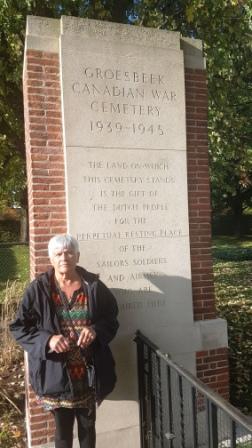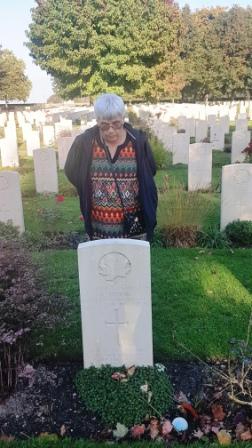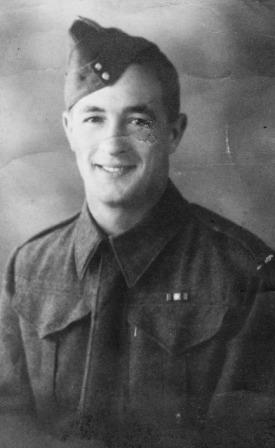August 20, 2023. After seeing Pieter in a TV interview last fall, Debbie Cook contacted us. “…I saw the episode on ATV/CTV … of what you are doing, and I say a huge ‘thank you’ to you both. I have 4 sons who are First Responders and I hold dear to my heart all those individuals in the Wars and all other First Responders who allow me to live free & happy as I have. My sons have a great-uncle who was killed overseas in WWII. His name was Harry Wright – do you have any information on him?…” (Link to the interview that Debbie saw: https://atlantic.ctvnews.ca/maritime-man-appealing-to-public-for-help-identifying-lost-canadian-soldiers-1.6143236)
It was a wide-ranging question as there wasn’t a lot of detailed information, but after checking, we found a Harry WRIGHT from Nova Scotia who was a trooper in the Lord Strathcona’s Horse (Royal Canadians) Regiment. He was buried in the Canadian War Cemetery in The Netherlands, and was on the cemetery’s photo wish list.
We asked Debbie if this could be her Harry Wright. “…He was in the army and yes from Nova Scotia. Harry was the uncle of my ex-husband. I believe we have a photo….” We had the right soldier and so the research began.
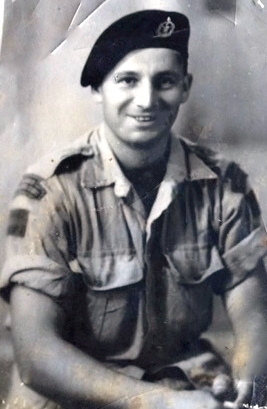
Harry Elwood Wright. (Photo courtesy of the Wright Family)
…Harry was born in Clementsvale, Nova Scotia…
Born in Clementsvale, Nova Scotia on September 2, 1916, Harry Elwood WRIGHT was the son of John Everett and Florence May Wright.

Map shows location of Clementsvale, Nova Scotia, where Harry was born, and the communities of Clementsport and Princedale. All three places are near Digby, Nova Scotia. (Map source: https://mapcarta.com/)
…Harry was an experienced mechanic….
When he enlisted at the No. 6 District Depot in Kentville, Nova Scotia on August 5, 1942, he had worked as a sawyer in a mill for 3 ½ years in Princedale, Nova Scotia, and drove a truck and worked in a garage for over 4 years. He was working for Mills Motors in Annapolis Royal as a mechanic and driver at the time of his enlistment.
His Personnel Selection Record noted that Harry was “…strong and robust…” with an “… aggressive, mature manner….” Although he had only a Grade 7 education, he had “…superior learning ability and mechanical aptitude…” The record went on to say that he had “…significant experience as truck driver and garage worker. Is able to do many minor repairs and has good knowledge of related theory…”
On August 15, 1942, Harry was sent to No. 60 Canadian Army Basic Training Centre (CABTC) in Yarmouth, Nova Scotia.
…Harry became a Canadian Armoured Corps Driver….
Once he completed his basic training, Harry was transferred to the A9- Canadian Armoured Corps (Advanced) Training Centre (CACATC) in Borden, Ontario on October 15, 1942. He arrived there just a few weeks ahead of another soldier living in Nova Scotia – Ronald Sidney WATERHOUSE (See https://onthewarmemorialtrail.com/2021/11/03/on-the-war-memorial-trail-remembering-ww2-soldier-ronald-sidney-waterhouse/)
By November 16, 1942, Harry qualified as a Class III Driver Wheeled, which meant he was qualified to drive heavy trucks and armoured cars. On December 12, 1942, he qualified as a Class II Driver Tracked, which meant he was trained to drive tracked vehicles, such as tanks. (See https://www.canadiansoldiers.com/vehicles/tanks/mainbattletanks.htm for an idea of the type of equipment Harry would have driven.)
…Harry left Canada for overseas service….
On March 9, 1943, he left Canada for the United Kingdom, arriving on March 17, 1943, where he was transferred to the No. 3 Canadian Armoured Corps Reinforcement Unit (CACRU).
Harry was sent for further training, successfully completing several courses for qualifying as a Driver Mechanic (MV) C and Driver Mechanic TK C. This meant that in addition to being a driver, Harry would also be responsible for minor vehicle repairs on vehicles in his unit.
On October 1, 1943, Harry was transferred to the 2nd Armoured Regiment – Lord Strathcona’s Horse (Royal Canadian). With the Regiment, Harry’s training continued in England with Canadian built Ram tanks, in preparation for the Italian Campaign. (See https://en.m.wikipedia.org/wiki/Italian_campaign_(World_War_II)).
“…The Regiment moved to the Mediterranean for service in November 1943…. One of the Regiment’s most noteworthy battles in Italy was at the Melfa Crossing, where the reconnaissance troop established a bridgehead on the Melfa River and held it against determined German tank and infantry attacks until reinforcements could arrive….” (See https://www.canadiansoldiers.com/regiments/armoured/lordstrathconashorse.htm)
…Harry and his Regiment left Italy for northern Europe…
On February 19, 1945, the Regiment left Italy as part of Operation Goldflake, arriving in Marseilles, France two days later. Operation Goldflake was the codename for moving troops from Italy to North-West Europe. (See https://en.wikipedia.org/wiki/Operation_Goldflake)
The Regiment moved through France as far as Iseghem, Belgium. The war diary summary for the month of March 1945 explained that it was “…quiet because of the lack of shells, exciting because we remained the entire month in the town of Iseghem, which was an entire change to our past Italian memories, which was not at all 100% pleasant…”
During the month “…a great deal of maintenance was done on vehicles…” and soldiers had opportunities to take leave. Harry was granted 9 days leave to the United Kingdom on March 28, 1945, returning back to his Regiment on April 7, 1945.
The stay in Iseghem was a prelude to what lay ahead. “…The end of March found the Regiment preparing its tanks for a proposed move…” By the time Harry returned from leave, the Regiment was in Malden, The Netherlands, south of Nijmegen.
On April 8, 1945, the war diary recorded that the Regiment “…passed through a part of Germany and back into Holland. Passed through flattened Cleve and Emmerich…”
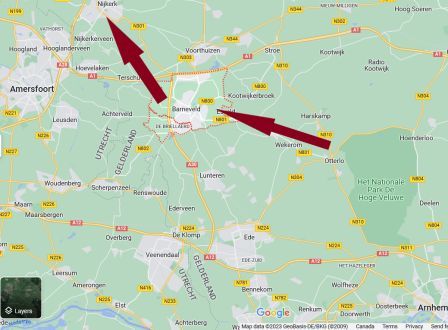
Map shows movement of the Lord Strathcona’s Horse Regiment from Otterlo to Barneveld towards Nijkerk. (Map source: Google maps)
Over the next few days, the Regiment encountered artillery fire as they moved to a staging area in Arnhem. The April 15, 1945 war diary entry noted that the “… Regiment fought from Arnhem to Otterlo…”
On April 16, 1945 the war diary reported that the Regiment was on the move. “…Rolling was good to Barneveld area where ‘A’ Squadron ran into a bit of trouble…”
The war diary entry for April 17, 1945 recorded that as they moved towards Nijkerk, their “…advance continued at a slower pace due to anti-tank guns, road blocks, and shelling…” 5 non-commissioned soldiers were reported killed in action. Among those killed was Harry Wright.
…Harry is buried at the Canadian War Cemetery in Groesbeek….
Harry was temporarily buried in Barneveld before being reburied the following year in the Canadian War Cemetery in Groesbeek, The Netherlands.

Grave of Harry Elwood Wright at the Canadian War Cemetery in Groesbeek. (Photo courtesy of Faces To Graves Groesbeek)
Thank you to Debbie Cook for contacting us and ensuring that a photo of Harry Wright was provided.
If you have a story to tell, please let Pieter know. You can email him at memorialtrail@gmail.com, comment on the blog, or send a tweet to @researchmemori1.
© Daria Valkenburg
…Want to follow our research?….
If you are reading this posting, but aren’t following our research, you are welcome to do so. Our blog address: https://onthewarmemorialtrail.com/
 4 countries, 6 weeks, 7,000 km – an unforgettable war memorial journey in Europe…. Daria’s book ‘No Soldier Buried Overseas Should Ever Be Forgotten‘ is available in print and e-book formats. Net proceeds of book sales help support research costs and the cost of maintaining this blog. For more information on the book, please see https://nosoldierforgotten.com/
4 countries, 6 weeks, 7,000 km – an unforgettable war memorial journey in Europe…. Daria’s book ‘No Soldier Buried Overseas Should Ever Be Forgotten‘ is available in print and e-book formats. Net proceeds of book sales help support research costs and the cost of maintaining this blog. For more information on the book, please see https://nosoldierforgotten.com/
Subscribe to our YouTube Channel: On The War Memorial Trail With Pieter Valkenburg: https://www.youtube.com/channel/UCJ591TyjSheOR-Cb_Gs_5Kw.
Never miss a posting! Subscribe below to have each new posting delivered to your inbox.

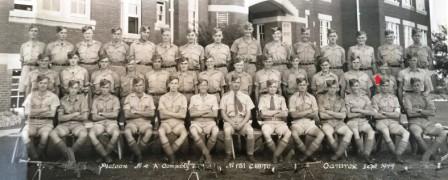
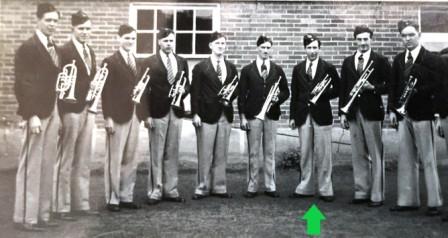
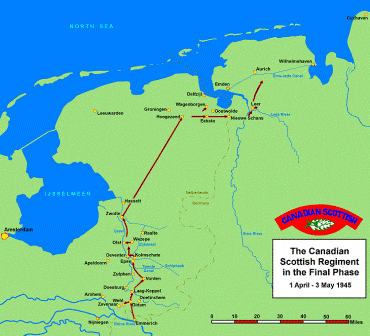
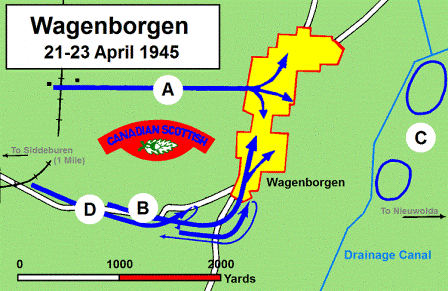


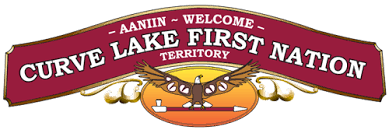 Born April 28, 1920, George TAYLOR was the son of Lorenzo ‘Dow’ and Eva Taylor, members of the Curve Lake First Nation, a Mississauga Ojibway First Nation located in Peterborough County, Ontario. (See
Born April 28, 1920, George TAYLOR was the son of Lorenzo ‘Dow’ and Eva Taylor, members of the Curve Lake First Nation, a Mississauga Ojibway First Nation located in Peterborough County, Ontario. (See 
